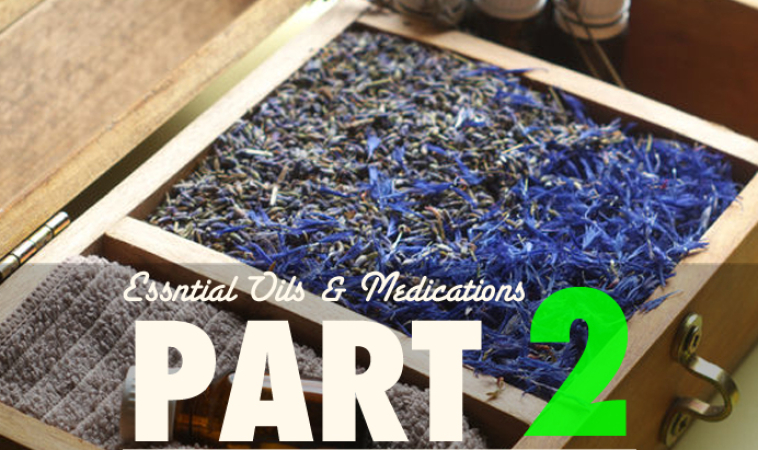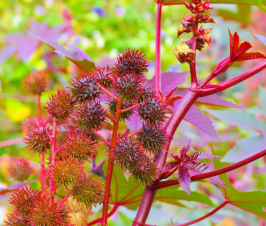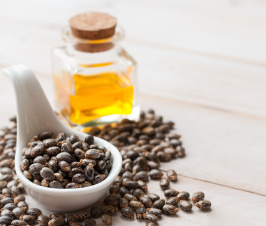Dr. Sarah LoBisco, ND
@DrLoBisco
As essential oils become an increasingly popular wellness tool, it’s important to consider how incorporating them into mainstream medicine can be done safely. For most, it is comforting to know, that when used as intended and with common sense, the documented safety of essential oils is impressive.
However, the combining of essential oils with medications has not been extensively studied. Further complicating this matter is the divergent views and trainings amongst aromatherapists.1As mentioned in my previous article, my suggestions are based on my research and 13+ years of experience of using essential oils personally and with my clients. The essential oils I use are standardized oils of high quality that combine the applications of inhalation, topical, and ingestion. They are not diluted or cut, alerted, or altered in any way.2 I cannot speak for those who wish to use essential oils that aren’t of highest quality.
In Part I, I reviewed four general guidelines to consider when using essential oils with medications. These included:
- Adjusting dosages of either as needed.
- Spacing out time between medication and essential oil use. I also reviewed why to be cautious when on blood thinners in relationship to timing and dosage.
- Why not to drink grapefruit juice or use grapefruit oil when on certain medications. This is because this pink fruit inhibits an enzyme needed to process various drugs.
- How to know when you using too many essential oils.
Now, I’m going to give some specific cautions to consider when mixing certain medications with essential oil use.
Caution Down Peppermint Lane
Peppermint has exhibited in vitro and vivo modulation of the motility of the digestive tract. Therefore, any medications that affect digestion could potentially interact with peppermint oil. It’s also important to note that any drugs that decrease stomach pH, such as H2 blockers or proton pump inhibitors (“antacids”), could theoretically cause enteric coated capsules of peppermint to dissolve earlier. This could lead to irritation in the stomach. (Enteric coating is used to prevent absorption in the stomach).
Natural Standard Database also reports potential interactions of peppermint with drugs that are metabolized by a certain liver enzyme, P4503A4.3However, this is more theoretical evidence and has not been demonstrated to be true in humans.3-4
The potential interaction of peppermint with nifedipine (a blood pressure medication) was also studied in vitro using human liver cells. Peppermint oil and its constituents menthol, menthyl acetate moderately, reversibly inhibited a metabolizing enzyme, which caused an increase amount in the body of this calcium channel blocker. The researchers noted, “this requires further investigation.”5
Essential Oils Use With Antibiotics- Is It OK or NAY?
There is in vitro evidence that that using essential oils with antibiotics have synergistic effects.6-`5One study investigated the relationship between several essential oils and beta-lactam antibiotics for their antibacterial effect against multidrug resistant bacteria. The authors concluded, “The finding highlighted the potential of peppermint, cinnamon bark and lavender essential oils being as antibiotic resistance modifying agent. Reduced usage of antibiotics could be employed as a treatment strategy to decrease the adverse effects and possibly to reverse the beta-lactam antibiotic resistance.” 6
In another in vitro study, a combination of essential oils with various antibiotics was tested in order to determine if their combined actions would be useful against antibacterial resistance. The authors found that 4 out of the 35 essential oil-antibiotic pairs showed synergistic effects and there was no interaction between the other pairs.7
Finally, another study demonstrated that an active constituent in oregano, carvacrol, exhibited inhibition of biofilms against microbes. Microbes form biofilms as a means to evade immune detection and are a known mechanism of resistance with superbugs.16
Unfortunately, human trials are lacking in combining both essential oils and antibiotics together, though the promise of this synergism with less resistance seems intriguing. This means, essential oils may actually assist with less resistance. This is something to consider with your doctor.
If you wish to ere on the side of caution, it may be best to stick with diffusing and topical applications rather than oral use, if one is taking an antibiotic medication. Furthermore, if you are going to take any form of microbe inhibitors, natural or synthetic, consider supplementing with a probiotic. I like S. boualardii, because of its diverse actions and clinical studies that support its use with antibiotics. 17-19
Careful with Pain Pathway Modulation: Caraway & Paracetamol (acetaminophen)
In a rodent study, the essential oil (EO) of caraway, prepared as emulsion, was applied to male mice for 5 consecutive days. 200mg/kg of Paracetamol was then applied orally or in an injection 2 hours after the last EO dose. The authors found different effects in medication levels based on route of administration. With oral dosage, there was less paracetamol in the rodent’s body. After injection, there was enhanced body exposure to the drug with the EO.
This study demonstrates the importance of spacing or avoiding caraway if taking acetaminophen. However, it has not been found in humans. 20
Avoid Anise with CNS Drugs
A potential interaction was demonstrated between codeine, diazepam, midazolam, pentobarbital, imipramine and fluoxetine in mice after 5days of pretreatment of aniseed EO. The authors found various modulatory effects between medications and anise EO. 21
General Precautions
The following precautions are based on theoretical and mechanisms of action of various essential oils.22-23
Pregnancy
Avoid: basil, calamus, clary sage, fennel, hyssop, nutmeg, rosemary, sage, tansy, tarragon.
(Safe oils include geranium, German chamomile, neroli, sandalwood, rosewood, lavender, myrrh, rose).
High blood pressure and epilepsy medications
Caution with basil, hyssop, fennel, peppermint, nutmeg, rosemary, sage, tansy, tarragon.
Avoid sage and rosemary with high blood pressure medications.
 Sarah Lobisco, ND, is a graduate of the University of Bridgeport’s College of Naturopathic Medicine (UBCNM). She is licensed in Vermont as a naturopathic doctor and holds a Bachelor of Psychology from State University of New York at Geneseo. Dr. LoBisco is a speaker on integrative health, has several publications, and is a certification candidate in functional medicine. Currently, she is the Director of Clinical Education for an esteemed nutraceutical company.
Sarah Lobisco, ND, is a graduate of the University of Bridgeport’s College of Naturopathic Medicine (UBCNM). She is licensed in Vermont as a naturopathic doctor and holds a Bachelor of Psychology from State University of New York at Geneseo. Dr. LoBisco is a speaker on integrative health, has several publications, and is a certification candidate in functional medicine. Currently, she is the Director of Clinical Education for an esteemed nutraceutical company.
References:
- National Cancer Institute – PDQ Cancer Information Summaries. Aromatherapy and Essential Oils (PDQ®) Health Professional Version. Last Update: December 30, 2014. Available at: http://www.ncbi.nlm.nih.gov/pubmedhealth/PMH0032645/
- D. Gary Young. Cultivating and Distilling Therapeutic Quality Eos in the United States. In: Proceedings from the Frist International Symposium: Integrated Aromatic Medicine Conference;March 21-22 1998. Grasse, France. Pg 139-150.
- Natural Standard Database. Peppermint Oil. (Professional Database-Subscription Required).
- Dresser GK1, Wacher V, Wong S, Wong HT, Bailey DG. Evaluation of peppermint oil and ascorbyl palmitate as inhibitors of cytochrome P4503A4 activity in vitro and in vivo. Clin Pharmacol Ther. 2002 Sep;72(3):247-55.
- Goerg KJ, Spilker TH. Effect of peppermint oil and caraway oil on gastrointestinal motility in healthy volunteers: a pharmacodynamic study using simultaneous determination of gastric and gall-bladder emptying and orocaecal transit time. Aliment Pharmacol Ther. 2003; 17: 445–451.
- Yap PS, Yiap BC, Ping HC, Lim SHE. Essential Oils, A New Horizon in Combating Bacterial Antibiotic Resistance. The Open Microbiology Journal. 2014;8:6-14. doi:10.2174/1874285801408010006.
- Yap PS, Lim SH, Hu CP, Yiap BC. Combination of essential oils and antibiotics reduce antibiotic resistance in plasmid-conferred multidrug resistant bacteria. Phytomedicine. June 2013;15;20(8-9):710-3. doi: 10.1016/j.phymed.2013.02.013.
- Sue Chao S, Young G, Oberg, C, Nakoka K. Inhibition of methicillin-resistant Staphylococcus aureus (MRSA) by essential oils. Flavour and Fragrance Journal. 2008; 23: 444-449. DOI: 10.1002/ffj.1904
- Boire NA, Riedel S, Parrish NM. Essential Oils and Future Antibiotics: New Weapons against Emerging ‘Superbugs’? J Anc Dis Prev Rem.2013;1: 105. doi:10.4172/2329-8731.1000105
- Becerril R, Nerín C, Gómez-Lus R. Evaluation of bacterial resistance to essential oils and antibiotics after exposure to oregano and cinnamon essential oils. Foodborne Pathog Dis. 2012; 9(8):699-705. doi: 10.1089/fpd.2011.1097. Epub 2012 Jul 24
- Edmondson M1, Newall N, Carville K, Smith J, Riley TV, Carson CF. Uncontrolled, open-label, pilot study of tea tree (Melaleuca alternifolia) oil solution in the decolonisation of methicillin-resistant Staphylococcus aureus positive wounds and its influence on wound healing.Int Wound J. August 2011;8(4):375-84. doi: 10.1111/j.1742-481X.2011.00801.x. Epub 2011 May 12.
- Rosato A, Vitali C, De Laurentis N, Armenise D, Antonietta Milillo M. Antibacterial effect of some essential oils administered alone or in combination with Norfloxacin. Phytomedicine. 2007 Nov;14(11):727-32. Epub 2007 Feb 15.
- Hongbin Si , Jinqiang Hu , Zhichang Liu , Zhen-ling Zeng Antibacterial effect of oregano essential oil alone and in combination with antibiotics against extended-spectrum B-lactamase-producing Escherichia coli.FEMS Immunology & Medical Microbiology.July 2008.
- Lorenzi V, Muselli A, Bernardini AF, et al. Geraniol Restores Antibiotic Activities against Multidrug-Resistant Isolates from Gram-Negative Species. Antimicrobial Agents and Chemotherapy. 2009;53(5):2209-2211. doi:10.1128/AAC.00919-08.
- Oluwatuyi M1, Kaatz GW, Gibbons S. Antibacterial and resistance modifying activity of Rosmarinus officinalis. Phytochemistry. 2004 Dec;65(24):3249-54.
- The Natural Antimicrobial Carvacrol Inhibits Quorum Sensing in Chromobacterium violaceum and Reduces Bacterial Biofilm Formation at Sub-Lethal Concentrations. PLoS ONE. 2014;9(4):e93414. doi:10.1371/journal.pone.0093414.
- Szajewska H, Mrukowicz J. Meta-analysis: non-pathogenic yeast Saccharomyces boulardii in the prevention of antibiotic-associated diarrhoea. Alimentary Pharmacology & Therapeutics. 2005; 22: 365–372. doi: 10.1111/j.1365-2036.2005.02624.x
- Efficacy of probiotics in prevention of acute diarrhoea: a meta-analysis of masked, randomised, placebo-controlled trials. Lancet Infectious Diseases.June 2006. 6(6): 374-382.
- Czerucka D, Piche T, Rampal P. Review article: yeast as probiotics –Saccharomyces boulardii.Alimentary Pharmacology & Therapeutics. 2007; 26: 767–778. doi: 10.1111/j.1365-2036.2007.03442.x
- Samojlik I, Ðakovi?-Švajcer K, Božin B, Mikov M. Herb-drug interactions: the influence of essential oil of caraway (Carum carvi L.) on the pharmacokinetics of paracetamol. BMC Pharmacology & Toxicology. 2012;13(Suppl 1):A27. doi:10.1186/2050-6511-13-S1-A27.
- Samojlik I, Mijatovi V, Petkovi S, Skrbi B, Božin B.The influence of essential oil of aniseed (Pimpinella anisum, L.) on drug effects on the central nervous system. Fitoterapia. 2012 Dec;83(8):1466-73. doi: 10.1016/j.fitote.2012.08.012. Epub 2012 Aug 25.
- Essential Science Publishing (compilation). Essential Oils Desk Reference4th ed. USA: Essential Science Publishing; 2007.
- Young G. Essential Oils Integrative Medical Guide 2nd ed. Canandaigua, NY: Life Sciences Press; April 1, 2003


















Great articles, Sarah. Highly informative. Wanted to let you know that a couple links in your article are broken, specifically, both references to your “Part I” article.